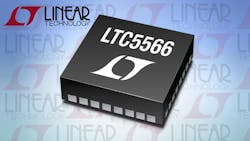Wideband Mixer Integrates Programmable IF Amplifiers
This file type includes high resolution graphics and schematics when applicable.
Modern wireless receivers, working with complex digital modulation formats and the wide bandwidths needed for high data rates, rely on such techniques as digital modulation and multiple-input, multiple-output (MIMO) antenna schemes to operate effectively. But to achieve optimum performance with diversity receivers and MIMO approaches, signal amplitude control is needed.
Fortunately, the dual-channel LTC5566 downconversion mixer from Linear Technology has that amplitude control built in, taking the form of two intermediate-frequency (IF) variable-gain amplifiers (VGAs) that contribute to a wide conversion-gain range for the dual-channel mixer, across a wide RF input range of 300 MHz to 6 GHz.
The dual-channel downconversion mixer (see figure) surrounds of pair of broadband frequency mixers with many of the components needed for a MIMO receiver, all on a single packaged integrated circuit (IC). The LTC5566 features two active mixers, fixed-gain local-oscillator (LO) amplifier for each channel, IF VGAs for each channel, and a serial peripheral interface (SPI). The SPI, or a parallel interface, can control mixer conversion gain as well as other functions, such as RF input tuning as well as a selection of a reduced-power mode for the mixer.
The LTC5566 offers conversion gain from −3.5 to 12.0 dB, programmable in 0.5-dB steps. Both on-chip mixers are optimized for use from 300 MHz to 5 GHz but can be used to 6 GHz with degraded performance. Single-ended RF input ports are matched to 50 ⦠by means of integrated RF transformers. Differential LO input ports can be driven with single-ended or differential signals. Differential IF output ports can be connected to differential IF filters and amplifiers in support of in-phase (I) and quadrature (Q) modulation schemes.
The two downconversion channels and their mixers are well isolated, with 50-dB channel-to-channel isolation from 300 MHz to 3.6 GHz. The isolation drops somewhat at higher frequencies, although it is still 40 dB at 4.5 GHz. The phase shift between channels is minimal across the frequency-conversion gain-control range, an important characteristic for MIMO receiver applications.
A real benefit of the LTC5566 is its integrated LO buffers, requiring only 0 dBm power to attain its specified performance. The LO power can vary by as much as ±6 dB with minimal effect on IP3 performance. Also, its RF inputs are rated to withstand as much as +20 dBm power for each channel, robust enough to handle high-level blocker signals. The dual-channel mixer achieves an input third-order-intercept (IIP3) point of +25.5 dBm. It operates with LOs from 150 MHz to 6 GHz and has an IF range of 1 to 500 MHz.
The differential IF gain error between any two 0.5-dB steps in the full 15.5-dB conversion loss/gain range is typically ±0.06 dB. The IF phase is also tightly controlled for the full 15.5-dB gain control range, with typical IF phase error of 2.4 deg. at IF of 150 MHz and 5.5 deg. at an IF of 350 MHz. The LO port input return loss is better than 10 dB from 150 MHz to 6 GHz.
The LTC5566 operates from a single +3.3 V dc supply with nominal current consumption of 384 mA with both channels active. Individual mixers can be turned on or off independently with separate control lines. In the LTC5566’s low-power mode, the current draw is reduced to 294 mA, although with some decrease in IIP3 performance. The mixer IC is supplied in a 5 × 5 mm, 32-lead plastic QFN package and is rated for operating temperatures from −40 to +105°C.
Linear Technology Corp., 1630 McCarthy Blvd., Milpitas, CA 95035-7417; (408) 432-1900
This file type includes high resolution graphics and schematics when applicable.
About the Author
Jack Browne
Technical Contributor
Jack Browne, Technical Contributor, has worked in technical publishing for over 30 years. He managed the content and production of three technical journals while at the American Institute of Physics, including Medical Physics and the Journal of Vacuum Science & Technology. He has been a Publisher and Editor for Penton Media, started the firm’s Wireless Symposium & Exhibition trade show in 1993, and currently serves as Technical Contributor for that company's Microwaves & RF magazine. Browne, who holds a BS in Mathematics from City College of New York and BA degrees in English and Philosophy from Fordham University, is a member of the IEEE.



